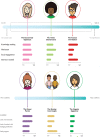Design and implementation of a novel patient-centered empowerment approach for pain optimisation in children undergoing major surgery
- PMID: 35853668
- PMCID: PMC9301787
- DOI: 10.1136/bmjoq-2022-001874
Design and implementation of a novel patient-centered empowerment approach for pain optimisation in children undergoing major surgery
Abstract
Background: Paediatric surgery is a stressful experience for patients and caregivers. While standardised protocols are the norm, patient-centred approaches are needed to empower patients/caregivers for an optimal perioperative pain experience. To address this gap, we employed a patient-centred approach using design thinking (DT) methodology to develop insights, map processes, identify opportunities and design solutions for individualised empowerment tools.
Methods: In consultation with DT experts, a multidisciplinary team of stakeholders (healthcare providers, patients who underwent pectus excavatum/scoliosis surgery and their caregivers), were invited to participate in surveys, interviews and focus groups. The project was conducted in two sequential stages each over 24 weeks-involving 7 families in stage 1 and 16 patients/17 caregivers in stage 2. Each stage consisted of three phases: design research (focus groups with key stakeholders to review and apply collective learnings, map processes, stressors, identify influencing factors and opportunities), concept ideation (benchmarking and co-creation of new solutions) and concept refinement.
Results: In stage 1, mapping of stress/anxiety peaks identified target intervention times. We identified positive and negative influencers as well as the need for consistent messaging from the healthcare team in our design research. Current educational tools were benchmarked, parent-child engagement dyads determined and healthcare-based technology-based solutions conceived. The 'hero's journey' concept which has been applied to other illness paradigms for motivation successfully the was adapted to describe surgery as a transformative experience. In stage 2, patient and caregiver expectations, distinct personas and responses to perioperative experience were categorised. Educational tools and an empowerment tool kit based on sensorial, thinking, relaxation and activity themes, tailored to parent/child categories were conceptualised.
Conclusion: DT methodology provided novel family centred insights, enabling design of tailored empowerment toolkits to optimise perioperative experience. Adapting the hero's journey call to adventure may motivate and build resilience among children undergoing surgery.
Keywords: focus groups; paediatrics; pain; patient-centred care; surgery.
© Author(s) (or their employer(s)) 2022. Re-use permitted under CC BY-NC. No commercial re-use. See rights and permissions. Published by BMJ.
Conflict of interest statement
Competing interests: None declared.
Figures


Similar articles
-
Optimizing Pediatric Induction Experiences Using Human-centered Design.J Perianesth Nurs. 2022 Feb;37(1):48-52. doi: 10.1016/j.jopan.2021.03.001. Epub 2021 Oct 20. J Perianesth Nurs. 2022. PMID: 34688538
-
Tailoring and evaluating an intervention to improve shared decision-making among seniors with dementia, their caregivers, and healthcare providers: study protocol for a randomized controlled trial.Trials. 2018 Jun 25;19(1):332. doi: 10.1186/s13063-018-2697-1. Trials. 2018. PMID: 29941020 Free PMC article.
-
Engaging patients and caregivers to establish priorities for the management of diabetic foot ulcers.J Vasc Surg. 2021 Apr;73(4):1388-1395.e4. doi: 10.1016/j.jvs.2020.08.127. Epub 2020 Sep 3. J Vasc Surg. 2021. PMID: 32891808
-
The relation between patient-centeredness and patient empowerment: a discussion on concepts.Patient Educ Couns. 2010 May;79(2):167-72. doi: 10.1016/j.pec.2009.08.008. Epub 2009 Sep 11. Patient Educ Couns. 2010. PMID: 19748203 Review.
-
Clinical Practice Guideline: Tonsillectomy in Children (Update)-Executive Summary.Otolaryngol Head Neck Surg. 2019 Feb;160(2):187-205. doi: 10.1177/0194599818807917. Otolaryngol Head Neck Surg. 2019. PMID: 30921525 Review.
Cited by
-
Current Evidence for Biological Biomarkers and Mechanisms Underlying Acute to Chronic Pain Transition across the Pediatric Age Spectrum.J Clin Med. 2023 Aug 9;12(16):5176. doi: 10.3390/jcm12165176. J Clin Med. 2023. PMID: 37629218 Free PMC article.
References
-
- Institute of Medicine (US) Committee on Quality of Health Care in America . Crossing the quality chasm: a new health system for the 21st century. Washington (DC: National Academies Press (US), 2001. - PubMed
-
- McDonagh D, Thomas J. Rethinking design thinking: empathy supporting innovation. Australas Med J 2010;3:458–64. 10.4066/AMJ.2010.391 - DOI
-
- Chambers P, Benz L, Boat A. Patient and family experience in the healthcare value equation. Curr Treat Options Pediatr 2016;2:267–79. 10.1007/s40746-016-0072-6 - DOI
MeSH terms
LinkOut - more resources
Full Text Sources
Medical
Miscellaneous
